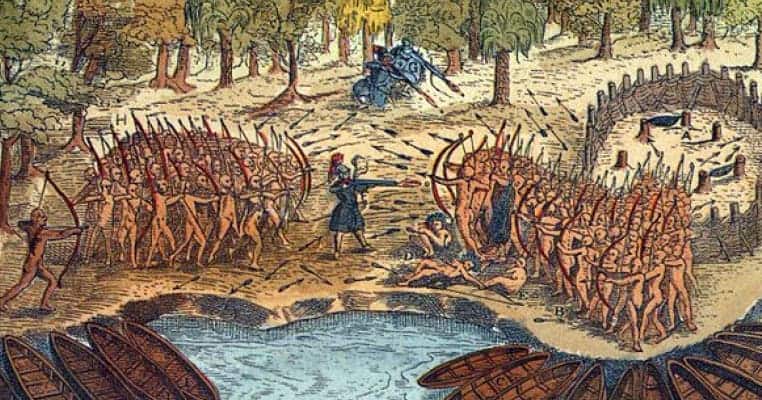After Christopher Columbus stumbled upon the New World, he set in motion numerous wars for empire that involved European powers. By the mid-1600s, Spain had exploited native populations and Portugal had expanded its African Slave trade into Brazil. The Iberian Peninsula was awash with silver that would make it one of the wealthiest regions in the world. The English, Dutch, and French wanted to take their own piece of the New World’s wealth. They packed ships with explorers and sent settlers to what would become Canada, New England, and New York and saw established the profitable fur trade.
Religious missions also traveled to the New World. Their objective was not furs but to save the souls of the heathen natives. Isaac Jogues was one such person. He suffered years of torture and banishment at the hands of Mohawk Indians who were convinced that all Europeans were evil and full of magic. This is the story of a Frenchman that remained steadfast to his faith while suffering unspeakable torture and as a result became a martyr and saint.

Called to Service
Isaac Jogues was born in Orleans, France in January 1607. At the time of his birth, European powers had begun fighting among each other as they laid claim to parts of the New World. Their purpose was to control all aspects of the land, including indigenous people, and to exploit it for raw materials. In doing so European powers were convinced that they would be able to control trade and commerce, become wealthy beyond their dreams, and build impenetrable navies and armies with which to protect the seas and New World landholdings.
Yet there were some people that had a call to service. Young Isaac Jogues was the fifth child of nine children. His parents were part of France’s growing bourgeois, the middle class. Along with his siblings, Isaac was taught at home by a tutor and then went off to a Jesuit school at 10. He entered into a Jesuit monastery at 17 and received an extensive education and religious training. After he took his religious vows, he prepared to become a missionary. In 1636, at 29, Isaac Jogues was ordained as a priest and traveled to New France. It was his goal to work with the native populations and to spread the word of Jesus among them. He desired to “devote himself to labor” in New France “for the conversion and welfare of the natives.”
Father Jogues did not travel across the Atlantic alone. There were other Jesuits that traveled with him and all were to become missionaries in New France. Jogues was assigned to work with the Huron and Algonquin Indians who were part of the Iroquois League and considered to be allies of France. The Jesuits arrived in the New World and then made their way to Quebec arriving in July 1636. Soon they settled on Lake Huron in the village at St. Joseph and they began their religious outreach.

As the Jesuits settled in to their new village, they began to reach out to the Hurons. This was a slow yet meticulous process. Father Jogues and his fellow Jesuits spent time getting to know the Hurons. They learned about the ways in which the Huron hunted and farmed, they learned about family ties and customs, and they learned their language. Perhaps most importantly, Father Jogues insisted on keeping with the Jesuit tradition of accommodating their ways to that of the Hurons. This was in stark contrast to the violent Spanish conquest of native people in present-day Mexico.
Europeans brought disease to the Hurons. Smallpox and measles killed many who had no natural resistance to these Old World diseases. As early as 1142, the Mohawk, Onondaga, Oneida, Cayuga, and Seneca people formed what the French called the Iroquois League as a way to band together for their own survival. These tribes believed that the Black Coats, named because of the robes that they wore, used magic to kill them with diseases and make their crops fail. The Jesuits, who meticulous acclimated to Huron customs, were able to convince the Huron that they did not possess magical powers, that they would not intentionally harm or exploit them, and that they were there only to “teach them, and to procure them their souls’ health.” Father Jogues lived among the Huron for six years.

